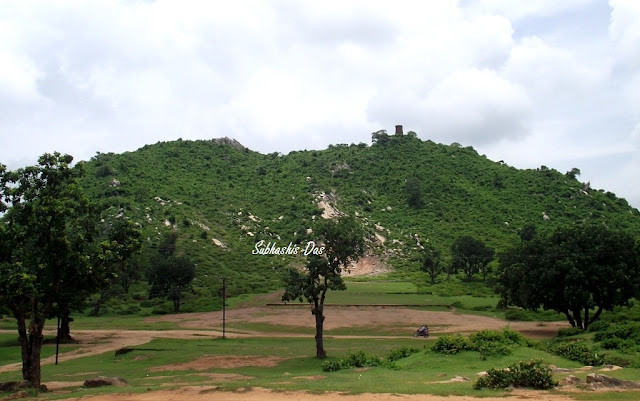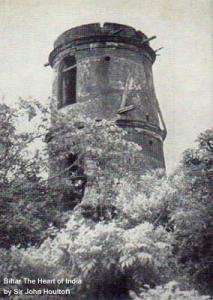Subhashis Das
Residents of Hazaribagh surely must have seen the tower atop the Silwar Hill. We have all wondered what on earth was it ? We knew this much that it was a British structure but were unaware of its purpose and its functioning till one Amitabha Gupta, a travel photographer from Kolkata came along. Amitabha has been doing an in-depth research on such towers across the country and has come across with a fascinating result.
 |
The Silwar Hill with the Semaphore Tower |
 |
A closer view of the double-storeyed Semaphore Tower on the Silwar hill |
 |
A rare sketch of the Silwar Hill and the kesura Hill with the old Benares Road. Now; Bagodar road. Courtesy Wikipedia Commons. |
The name and purpose of the tower :
Research has shown the tower atop the Silwar Hill is actually an optical telegraphic tower constructed by the East India company during the period of 1816 - 1828. Such towers are called SEMAPHORE TOWERS which in Greek means "Bear a sign".
Semaphore Towers were first invented in France there after were developed by the British.
In 1813 It was decided by the East India Company to construct a network of Optical Telegraph Towers in India to communicate information and messages across the country. Several lines of Semaphores were planned to be laid down to major places from Calcutta. A line was planned between Calcutta and Bombay. And another between Calcutta and Chunar in the then United Provinces in which the Silwar Hill would be "on" the line..
On 21st Oct 1817 Sir George Everest was entrusted with the hectic task of surveying the distance of about 400 miles between Calcutta and Chunar. Assisting him his in this tedious job was Lieutenant Ferguson of the Ramgarh Battalion. French engineers were thereafter brought from France to build and layout a network of these Semaphores across the country.
 |
Closer view of the the Semaphore Tower on Silwar Hill. From the book: Bihar; the Heart of India by Sir John Houlton |
The tentative name of places in which the line of Semaphore Towers were
to be erected between Calcutta and Chunar were Calcutta, Howrah, Hoogly,
Bankura, Purulia, Chas, Chandankiari, Gomia, Hazaribagh (Sillwar),
Katkamsandi/Itkhori (Bhusua), Kanhachatti, Dhangain, Gaya and Chunar.
The line was created along the Old Benares road which is the Bagodar, Hazaribagh and Katmasandi Road today. Amitabha has yet not been able to trace all the towers in this route as a couple of names of places of the location of the Semaphores are indeed missing.
The main operating station however was at Fort William Calcutta.
The Construction:
The completion of the Semaphore Tower of Silwar was done by 1855. The Silwar Semaphore Tower is a double storeyed structure with two same sized large doors facing the South-East. The circular structure is hollow from inside and is devoid of any ceiling. Inside there are holes on the walls for beams to be shoved inside them. The plastering has been done with bricks and chuna-surki. Outside channels are visible on which ropes were possibly laid to tie the mount atop the tower.
 |
Three linear channels can be seen on the outer walls. |
 |
Ropes were probably used to tie the mount. Pic courtesy Amitabha Gupta. |
The Functioning :
But how did the Semaphore tower atop the Silwar Hill function?
There were a few models of Semaphores the world over. Exactly which model was used in Silwar is difficult to adduce right now. However Amitabha is of the view that the shuttered system of mount on the tower may have been used to convey messages.
The shutters were simple mechanisms operated from inside the Semaphores.
Mounted on these towers were various wooden structures which were moved with pulleys fixed in the Semaphore which conveyed coded messages to the next tower. The person in-charge of these towers would watch each others' with telescopes for messages.
Why were they deserted?
Firstly because maintaining these Semaphores across the country was an expensive matter. Secondly, Morse's Telegraph was invented roundabout that period which was a more viable and inexpensive mode of transmitting messages.
Both took a toll on these rare monuments and they fell into disuse pushing them into history today.
Credit to Amitabha Gupta for his stupendous research on the Semaphore Towers. I am grateful to him for letting me use a few of his photographs as well as his research. This is his blog:
http://amitabhagupta.wordpress.com/2013/07/15/optical-telegraph-in-india-the-forgotten-saga/#more-1564.




This is a very fascinating account of that tower on silwar. Thanks for this post.
ReplyDeleteImpressive and mesmerized by knowing this such a good topic
ReplyDeleteAfter reading the blog of mr.Amitabh gupta accidentally online,maybe few months ago.I being a lover of historic monuments,Climbed up the silwar hill and managed to reach the tower somehow.It wasnt an easy job for me.I and my friend were expecting it to be an easy job,but it was all rocks we climbed.Anyways...I was a bit curious that could i find the tower at katkamsandi and luckily i have noticed it a week ago on my trip to dwari kund. I am damn excited and desperate to visit the place.I would surely reach up there within this week......
ReplyDeleteIt is really a good job did by our brother Amitabh Gupta. After seen this tower, I am so curious about it, but this research help me lot. Thank you brother Amitabh....
ReplyDeleteI stayed in Meru for 7 years and during that time I climbed upto this tower 4-5 times with my friend Rakesh. Climbing from temple side is bit easier. It's a wonderful structure and British period guest house atop Canary hill is also a good place to spend time.b
ReplyDelete